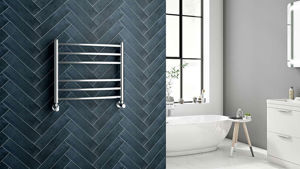We have all seen pictures in home improvement magazines of a beautiful, classic freestanding bath placed in the centre of a grand and spacious bathroom. Freestanding baths are the epitome of bathroom luxury. However, plumbing a freestanding bath can seem mind boggling and in some cases even deter homeowners from buying....
There is a common misconception that freestanding baths are a hassle to have installed and involve significant disruption which is not necessarily the case. Installing a freestanding bath can be as straight forward as plumbing in an ordinary bath, as you are about to find out. The process of plumbing a freestanding bath works the same way as regular bath tub being plumbed, with a waste in the front leading to the drain pipe adjacent to the hot and cold water pipes that stop at your tub, or continue up to your shower. The only difference is that regular bathtub has plumbing that works behind the scenes, whereas freestanding plumbing works from the front and centre. The plumbing of a freestanding bathtub can also work as a design feature.
Traditionally exposed metal pipes made from brass covered in chrome, copper or brushed nickel that are ornate in their simplicity can run all the way up to the ceiling, down through the floor or partially up the wall as they would have done in Edwardian times, along with matching brass ware to enhance the bathtub, or peek up over the back corner with unobtrusive pipes going through the floor.
Plumbing a Freestanding Bath
First of all, your plumber will need to turn off your properties main water supply at the stop cock. After carefully unwrapping your bath, your plumber will then carefully turn the bath upside down so that they can fit the feet on. It is advisable to lay the bath on a doubled up dust sheet to avoid scratching the enamel or acrylic surface. The feet should be screwed in with no more than 20mm screws as any longer may damage the bath. The height of the bath may then be measured either side with a tape measure to check each side is set to the desired height. Once the bath is set to the correct height the screws in the feet should be secured firmly.
NOTE: Freestanding baths must be positioned with a minimum 50mm gap between the bath & any wall surface. This is to allow movement of the bath whilst entering & exiting the bath.
At this point your bath may be raised onto some timber slabs to allow access under the bath to make the final connections.

Drilling Tap Holes & Tap Installation
Your plumber will now need to drill the bath to fit your mixer taps and waste, using masking tape to mark the bath where the holes are going to be drilled. Your plumber will mark the centre line of the bath allowing 90mm either side to give 180mm for mixer tails then drill holes in the centre of the rim using a 32mm tank cutter.
Having drilled through the bath safely, the masking tape marking the area will need to be peeled off in order to mount the bath mixer securely to the rim of the bath with the flexible tap connectors already attached to the tap before positioning it on to the bath in order for it to be connected to your hot and cold supplies directly.
Putting Pipe Work in Place
If you are having freestanding bath taps, start by marking out the bath position on the bare floor boards, then mark out the position of the pipe work in relation to the bath, next drill holes for supply pipes, then start to lift floor boards to run pipe work up through holes leaving copper tails sticking out enough to connect on to, taking in to account thickness of ply, adhesive & floor tiles if applicable. Your pipe work should now be capped off and tested for any leaks. Re-lay floorboards, ply, tile (if applicable) and fit bath.
Next your plumber will run 22mm hot and cold supplies under the floor to where the bath will sit, then connect two bends to the pipe work, slide over the chrome shrouds and then connect the copper pipes to the taps in the same way that regular taps are fitted. Once this is done fix down the chrome stands to the floor, the chrome sleeves should then slide or screw into position. The taps should come with instructions as to what centres your pipes need to be and how much copper to have sticking up through the finished floor.
Once your pop up waste has been fitted, your plumber will connect the bath waste into the floor through pre-drilled holes. Now everything is in place, your plumber will disconnect the pipe work and remove the timber framing in order to position the bath in its correct place. Once all the pipe work is re-connected your plumber should undertake a wet test to check all pipe work is in place and no leaks exist. If your bath has claw feet that are secured to the floor, it is at this point that your plumber will fix them to the floor. To finish off ensuring the surfaces of your bath are completely dust and grease free, your plumber will add a silicone bead along joint between panel and floor to secure the installation.
After allowing 24 hours for the silicone bead to dry, Voila! - Your new freestanding bath is ready for you to take a soak in.






